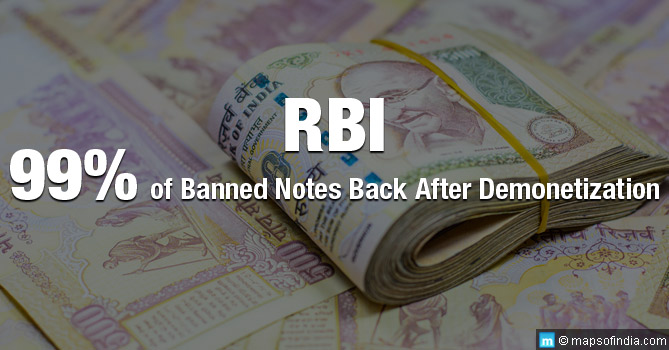On 8 November last year, PM Narendra Modi initiated one of the largest demonetization exercises ever seen in this country. In what the PM called “Surgical Strike Against Black Money”, INR 500 and INR 1000 notes were withdrawn as legal tender and the move was a drastic and sudden one. Despite being highly inconvenienced, the people of India were glad to suffer since the move came with a vision of a cleaner economy.
RBI’s Recent Report & What It Means
According to a recent report by the Reserve Bank of India, the central bank of the country, about 98.6 percent of the old INR 1000 and INR 500 notes (1,716.50 crore pieces in circulation) that were demonetized last year have been returned by end June 2017. The Minister of State for Finance Arjun Meghwal had previously informed the parliament that of the INR 15.44 trillion that was in circulation in the form of banned notes, INR 15.28 trillion has been received.
The demonetization drive was premised on the assumption that a majority of the illegal cash stashed in the country was held in these higher denomination notes. Even if we make space for the miniscule amount of fake notes received by the RBI, the entire exercise seems to have been a futile one. The demonetization seems to have flushed out only black money worth 0.1 percent of the GDP. The economy, however, slowed down by about 1 percent of the GDP due to the lack of liquidity. Was the entire exercise worth it, ask the critics of the NaMo government.
As far as flushing out black money goes, it seems that hoarders seem to have resorted to some other holdings or found a way to legitimately convert their black money into the new currency.
Finance Minister Arun Jaitley, however, vehemently defended the demonetization drive despite the Opposition’s criticism. Calling the exercise a great success, he said that the “object of demonetization was not confiscation of money”. He added that RBI data reveals that the volume of cash in circulation has been reduced by 17 percent. This could imply that digital currency or electronic money is more in use. The advantage of reducing cash transactions is that all other modes of payment are easily traceable by the IT department, destroying the environment in which black money festers.
Tax Evaders
While we’re yet to benefit (on the black money front) from the demonetization of old INR 500 and INR 1000 notes, the government has certainly been able to identify as many as 18 lakh tax evaders. The Income Tax department reported that these people whose cash deposits during the demonetization drive were not in keeping with their IT profile. These people were sent intimations asking them to explain the deposits. The tax department has received 9.27 lakh responses involving the deposit of INR 2.89 lakh crore in 13.33 lakh accounts. All these people are now under the scanner of the IT department. A further 5.56 lakh people have been identified by the department’s new data analytics systems. It is likely that we may see action against at least 1 lakh people who have not responded to their notices from the tax department. What is heartening, however that there has been a 25 percent increase in the number of IT returns filed for the last fiscal year. This implies that more people are now under the taxman’s surveillance and this leaves less scope for black money circulation.
Increased Expenditure
While discussing the fallout of the demonetization drive, we must also mention here that the costs incurred by the Reserve Bank of India post demonetization have also gone up considerably. The RBI mentioned that the cost of printing new INR 500 and INR 2000 notes is pegged at about INR 7,965 crore. This is almost twice the amount spent on printing currency notes the previous year (estimates for the previous year were about INR 3,421 crore). We’re yet to understand the cost implications of printing the new INR 200 and INR 50 notes that are set to be in circulation soon.
While demonetization has not (apparently) done much to reduce the quantum of black money in the country, it has been a great political success for PM Narendra Modi and the NDA government. Demonetization is largely perceived as one of the largest anti-black money operations of modern times – a perception that is likely to go down well with the electorate of the country.





